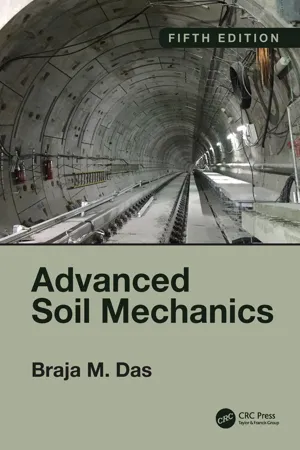
- 712 pages
- English
- ePUB (mobile friendly)
- Available on iOS & Android
Advanced Soil Mechanics, Fifth Edition
About This Book
Now in its fifth edition, this classic textbook continues to offer a well-tailored resource for beginning graduate students in geotechnical engineering. Further developing the basic concepts from undergraduate study, it provides a solid foundation for advanced study.
This new edition addresses a variety of recent advances in the field and each section is updated. Braja Das particularly expands the content on consolidation, shear strength of soils, and both elastic and consolidation settlements of shallow foundations to accommodate modern developments.
New material includes:
-
- Recently published correlations of maximum dry density and optimum moisture content of compaction
-
- Recent methods for determination of preconsolidation pressure
-
- A new correlation for recompression index
-
- Different approaches to estimating the degree of consolidation
-
- A discussion on the relevance of laboratory strength tests to field conditions
-
- Several new example problems
This text can be followed by advanced courses dedicated to topics such as mechanical and chemical stabilization of soils, geo-environmental engineering, critical state soil mechanics, geosynthetics, rock mechanics, and earthquake engineering. It can also be used as a reference by practical consultants.
Frequently asked questions
Information
Table of contents
- Cover
- Half Title
- Title Page
- Copyright Page
- Dedication
- Contents
- Preface
- Acknowledgments
- Author
- 1. Soil aggregate, plasticity, and classification
- 2. Stresses and strains: Elastic equilibrium
- 3. Stresses and displacements in a soil mass: Two-dimensional problems
- 4. Stresses and displacements in a soil mass: Three-dimensional problems
- 5. Pore water pressure due to undrained loading
- 6. Permeability
- 7. Seepage
- 8. Consolidation
- 9. Shear strength of soils
- 10. Elastic settlement of shallow foundations
- 11. Consolidation settlement of shallow foundations
- Appendix: Calculation of stress at the interface of a three-layered flexible system
- Index